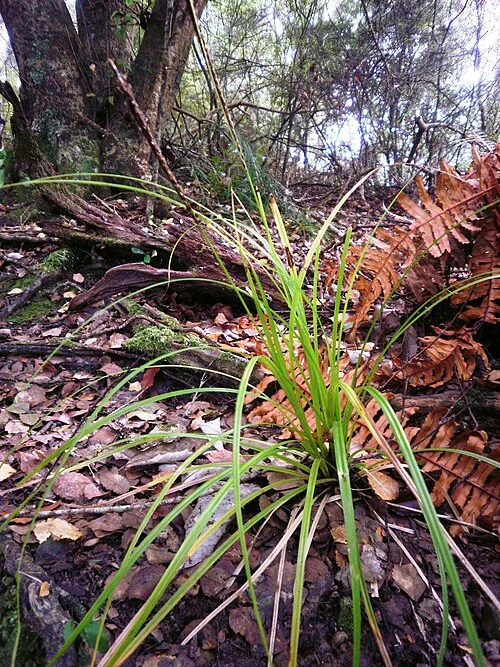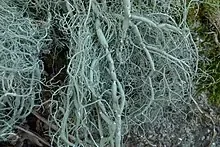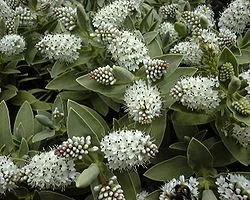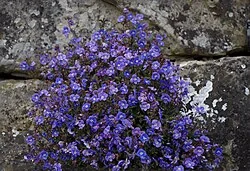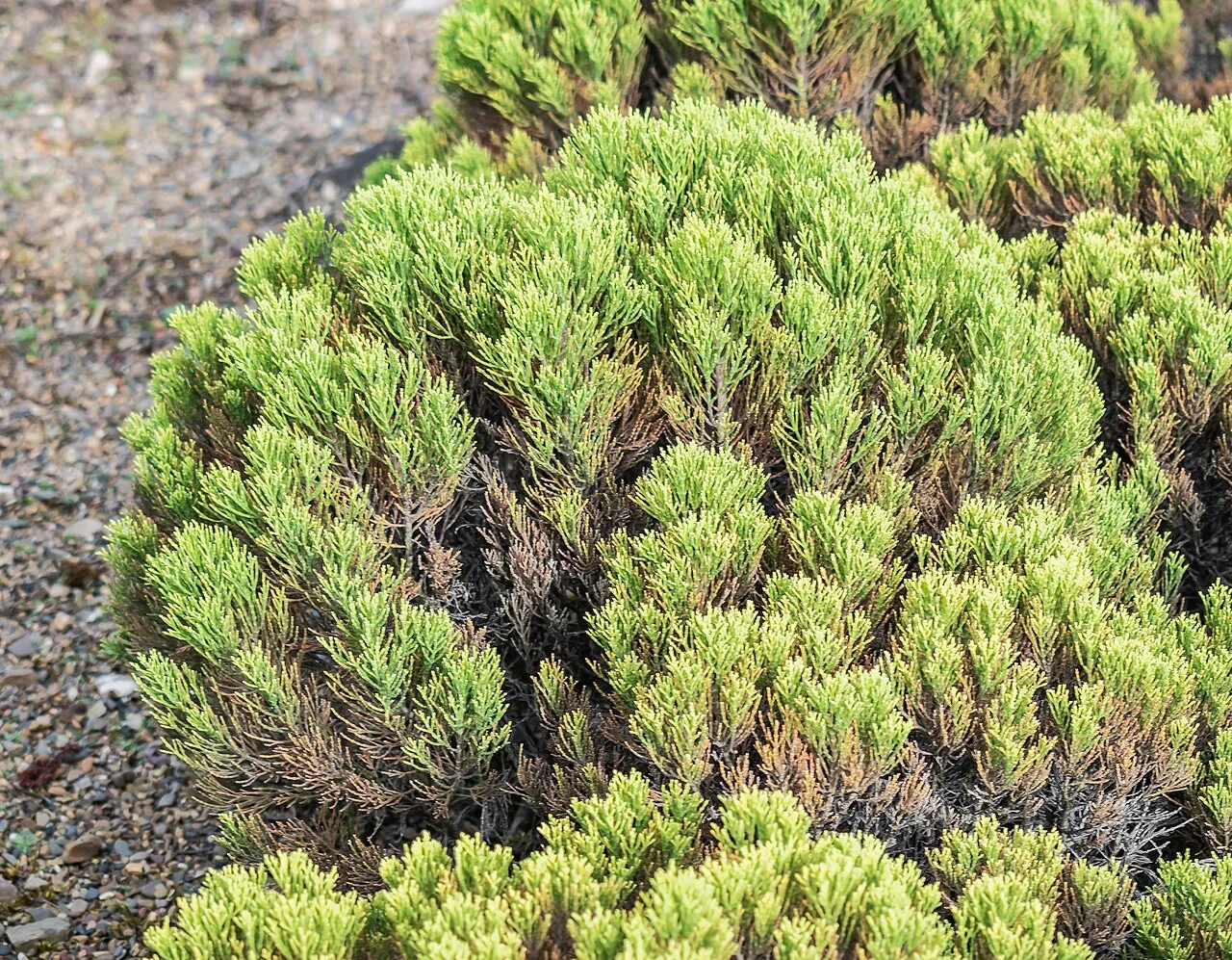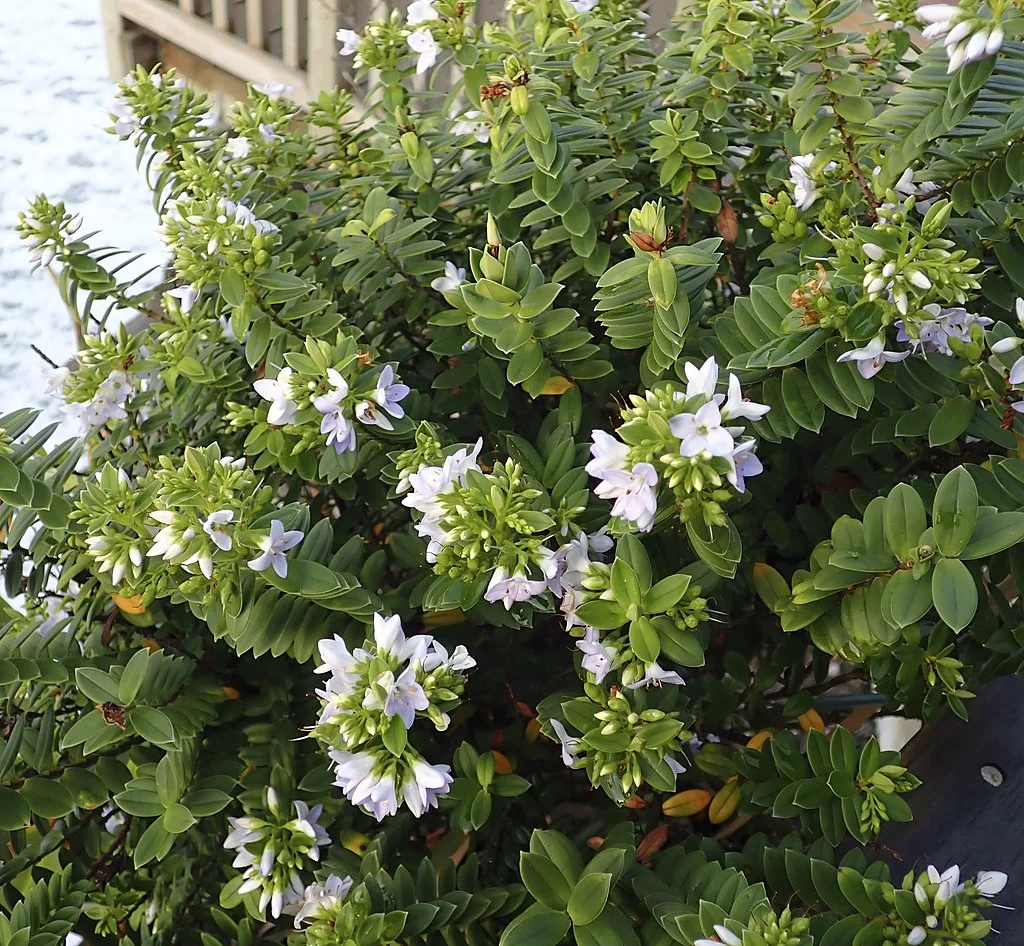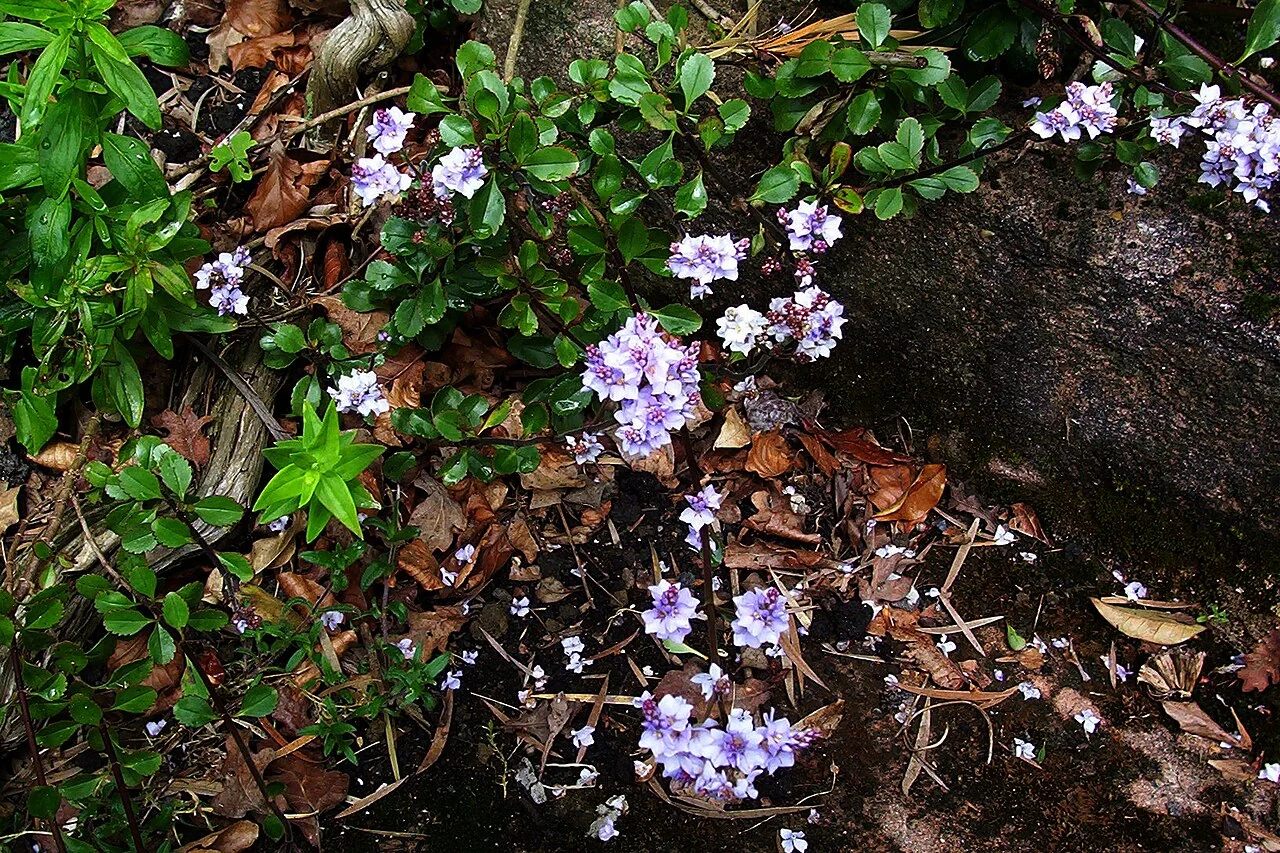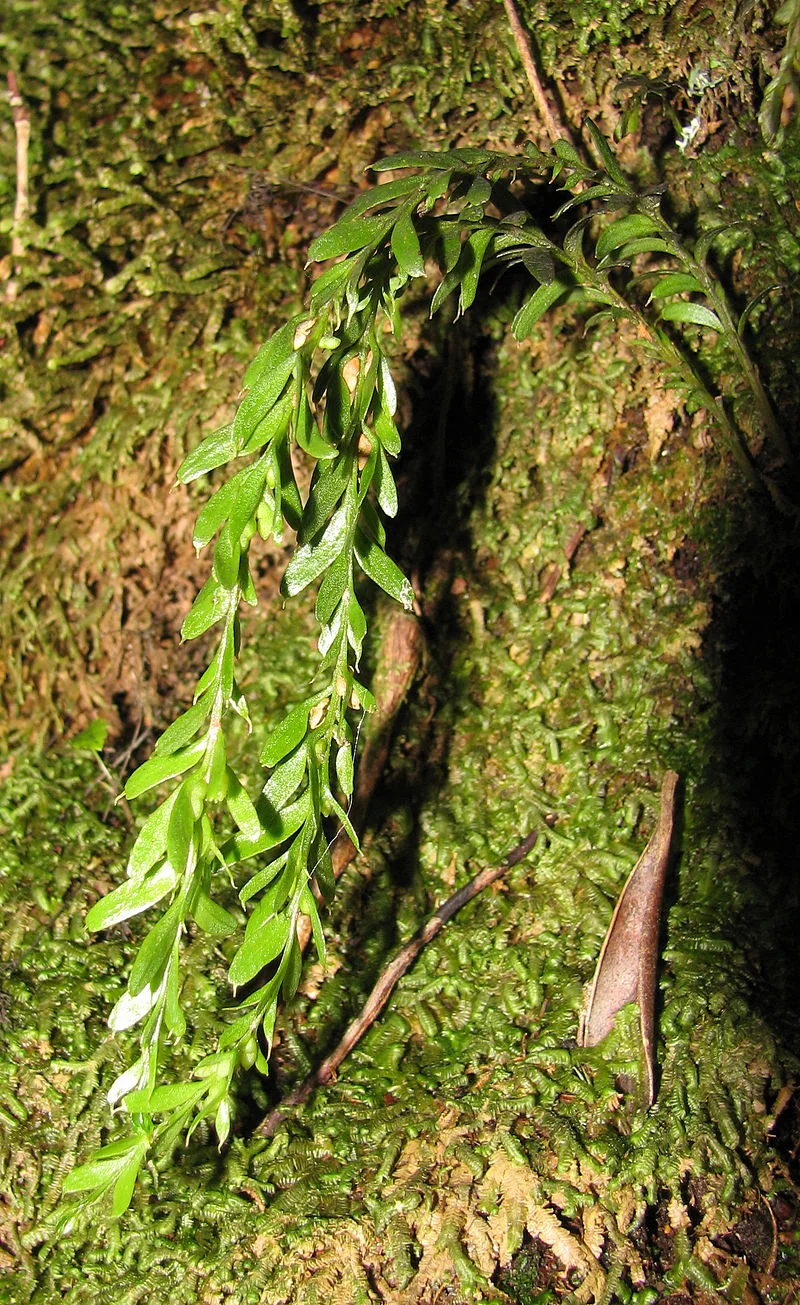
Long Fork Fern
Tmesipteris elongata
A primitive fern ally, epiphytic on tree-fern trunks (especially Cyathea spp.) in humid forests. Flattened, strap-like fronds bear paired sporangia. Demands persistent humidity and shade; best grown in ferneries or mounted on suitable substrates among our native ferns.

Plant Description
Botanical Features
Long Fork Fern (Tmesipteris elongata), commonly known as fork fern, is a fern ally endemic to southeastern Australia and New Zealand. It is often found growing as an epiphyte on soft tree ferns in moist valleys, though it can also be terrestrial or grow on other trees, cliff faces, or rocks. This primitive plant is characterized by its pendulous, unbranched or dichotomously branched aerial stems, which can reach lengths of 80-1180 mm. It lacks true roots, instead absorbing water with filamentous rhizoids from a creeping rhizome. The plant also lacks true leaves, with its photosynthetic function carried out by spirally arranged, dull green, narrow, tapering, and flexible scale leaves that are 10-42 mm long. Its sporangia (spore-producing structures) are rounded, fused in pairs (synangia), and located on the upper surface at the base of forked fertile leaves.
Quick Facts
Quick Facts Overview
| Scientific Name | Tmesipteris elongata |
|---|---|
| Height | 0.2-0.6 m fronds |
| Spread | Clumping on host trunks |
| Light | Deep shade |
| Humidity | Very high; constant |
| Water Needs | Regular misting; never dry out |
| Frost Tolerance | Varies |
| Salt Tolerance | Varies |
| Growth Rate | Varies |
| Lifespan | Varies |
Climate Best Suited to
Overview
Long Fork Fern thrives in New Zealand's humid, temperate forests with consistent moisture and protection from direct sunlight. It prefers stable, cool conditions with high humidity found in mature forest understories.
Regional Suitability
| City | Climate Suitability |
|---|---|
| Auckland | Ideal |
| Wellington | Ideal |
| Christchurch | Good |
| Dunedin | Moderate |
| Whangārei | Ideal |
| Hamilton | Ideal |
| Tauranga | Ideal |
| Rotorua | Ideal |
| Gisborne | Ideal |
| New Plymouth | Ideal |
| Napier | Ideal |
| Whanganui | Ideal |
| Palmerston North | Ideal |
| Nelson | Ideal |
| Invercargill | Ideal |
Natural Habitat
Long Fork Fern (Tmesipteris elongata) is a primitive fern ally primarily found in southeastern Australia and New Zealand. In New Zealand, it is widespread across the North Island, South Island, Stewart Island, and Chatham Islands.
Key Habitats Include:
- Epiphytic Growth: It commonly grows as an epiphyte, meaning it lives on other plants, particularly on the trunks of tree ferns such as Cyathea dealbata, Dicksonia squarrosa, Cyathea medullaris, and Cyathea smithii. It can also occasionally be found on the trunks of other trees like Beilschmiedia tawa, Dysoxylum spectabile, Hedycarya arborea, Melicytus ramiflorus, Metrosideros robusta, and Nestegis species.
- Moist Valleys and Humid Forests: It thrives in moist valleys and within mature stands of Cool Temperate Rainforest, indicating its preference for high humidity and consistent moisture.
- Terrestrial and Lithophytic Growth: Less frequently, it grows on cliff faces, in rock crevices, or among mosses on the ground, showcasing some adaptability beyond its typical epiphytic habit.
Preferred Conditions:
- Altitude: In New Zealand, it occurs in lowland to montane forests at altitudes ranging from 0 to 925 meters.
- Shade and Humidity: It requires persistent humidity and shade, making it best suited for ferneries or mounted on suitable substrates in humid forest understories.
The unique epiphytic growth habit and preference for humid forest environments of Tmesipteris elongata underscore its ecological importance in contributing to the biodiversity and structural complexity of New Zealand's native forests.
Plant Conservation
Tmesipteris elongata, commonly known as the Slender Fork-fern, is a perennial epiphytic fern found in southeastern Australia and New Zealand. In New Zealand, Tmesipteris elongata is currently classified as "Not Threatened" as of 2017. However, in Victoria, Australia, it is classified as Critically Endangered, facing threats from bushfires, drought, deer, forestry operations, and habitat clearing. The fern typically grows on the trunks of tree ferns within cool temperate rainforests, and can also be found on other trees, decaying logs, banks, or in humus. It is a long-lived species, with an estimated generation length of 50 to 100 years.
Growing Requirements
Light Requirements
Requires deep to moderate shade. Cannot tolerate direct sunlight which will quickly damage the delicate fronds.
Humidity Requirements
High humidity essential. Benefits from misting in dry conditions and sheltered positioning.
Soil Requirements
Prefers well-draining but consistently moist, humus-rich forest soil with good organic content.
Planting Guide
Tmesipteris elongata, commonly known as fork fern or slender fork-fern, is a unique plant primarily found as an epiphyte in humid forest understories of New Zealand and parts of Australia. It lacks true roots and leaves, instead absorbing water through filamentous rhizoids and featuring flattened stems that resemble leaves.
Habitat and Growing Conditions:
- Epiphytic Nature: Tmesipteris elongata thrives as an epiphyte, typically growing on the trunks of tree ferns, particularly Dicksonia and Cyathea species. It can also be found on other tree trunks, old rotten logs, and occasionally on banks or in humus.
- Humidity: This plant requires high humidity and consistently moist conditions, reflecting its natural environment in damp, shaded forests.
- Light: It prefers shaded environments, consistent with its understory habitat.
- Temperature: It is found in warm temperate rainforests, from coastal to montane regions.
Planting and Care:
- Mounting: To mimic its natural epiphytic growth, Tmesipteris elongata should ideally be mounted on a suitable host. Tree fern trunks are ideal, but it can also be attached to other rough-barked trees or logs.
- Substrate (if not epiphytic): If not grown epiphytically, ensure a well-draining substrate that retains moisture, such as a mix suitable for ferns or orchids.
- Watering: Maintain consistent moisture. If grown indoors, watering twice a week may be necessary to keep the environment moist.
- Humidity: High humidity is crucial. Consider placing the plant in a terrarium, using a humidity tray, or misting regularly, especially in drier indoor environments.
- Light: Provide indirect light or partial to full shade. Avoid direct sunlight, which can scorch the delicate stems.
- Pruning: Prune in early spring to remove any dead or damaged fronds. This can help promote new growth and maintain the plant's shape.
Ecological Role
Epiphytic Specialist
Fork fern (Tmesipteris elongata) typically grows as an epiphyte on tree fern trunks in humid forests, where it contributes to the diverse epiphytic layer that harbours invertebrates and retains moisture around the host.
Uses and Significance
Garden Uses
- Specialist plant for cool, humid ferneries
- Excellent for deep shade forest gardens
- Ideal for creating prehistoric garden themes
- Educational value as living fossil
Ecological Significance
- Important indicator of pristine forest conditions
- Living fossil representing ancient plant lineages
- Part of specialized forest floor ecosystems
Landscaping Ideas
Fernery and Epiphyte Displays
Mount fork fern on ponga logs in humid shade alongside filmy ferns and mosses for a naturalistic epiphyte display. Avoid direct sun and drying winds.
Seasonal Care
Long Fork Fern (Tmesipteris elongata) is a primitive epiphytic fern ally that thrives in consistently humid, shaded environments. Its seasonal care focuses on maintaining these conditions to support its unique growth habit on tree-fern trunks.
Spring
- Active Growth: Spring is an active growth period for Long Fork Fern. New fronds may emerge.
- Watering and Misting: Maintain consistent moisture in its substrate and ensure high humidity through regular misting, especially as temperatures warm.
- Fertilizing: If new growth is appearing, a very gentle, diluted liquid feed (e.g., half-strength or third-strength fish and seaweed emulsion) can be applied.
Summer
- Humidity: High humidity is crucial. Continue regular misting, especially during hot periods, to prevent fronds from drying out.
- Watering: Ensure the substrate remains consistently moist but never waterlogged.
- Light: Protect from direct sunlight, which can scorch the delicate fronds. Maintain dappled or indirect light.
Autumn
- Humidity: Continue to provide high humidity, though misting frequency might be slightly reduced as temperatures cool.
- Watering: Monitor moisture levels and reduce watering frequency slightly as growth slows.
Winter
- Protection: Long Fork Fern is sensitive to cold. Ensure it is protected from frost and cold drafts. If grown outdoors in cooler climates, consider moving it to a sheltered, frost-free location.
- Humidity: Maintain consistent high humidity, especially if grown indoors in heated environments.
- Watering: Water sparingly, allowing the substrate to dry out slightly between waterings, but never completely dry out.
Pruning
Techniques and Timing
Long Fork Fern (Tmesipteris elongata) generally requires minimal pruning. Its primitive nature means it does not develop complex branching structures that typically require shaping. Pruning is primarily for aesthetic purposes and to maintain plant health.
- Remove Dead or Damaged Fronds: Regularly inspect the plant and carefully remove any fronds that are dead, yellowing, or damaged. Cut these back to their base using clean, sharp scissors or a small knife.
- Minimal Intervention: Avoid any significant structural pruning. The plant's natural form is part of its unique appeal.
- Timing: Pruning can be done at any time of year as needed, but it's often easiest to identify and remove unhealthy fronds in spring as new growth begins.
- Handle with Care: Be gentle when handling the plant, as its fronds can be delicate.
How to Grow Long Fork Fern
Long Fork Fern (Tmesipteris elongata) represents one of New Zealand's most primitive and specialized fern allies, dating back over 400 million years. This epiphytic species requires very specific conditions that replicate its natural forest habitat, making it one of the most challenging native plants to cultivate successfully. However, for dedicated enthusiasts with appropriate facilities, it offers the unique opportunity to grow a living fossil that connects us to ancient botanical lineages.
From Spores
Spore propagation is the natural method for Tmesipteris elongata reproduction, though it requires exceptional expertise and specialized equipment to achieve success. This species has a unique reproductive cycle involving buried, non-photosynthetic gametophytes that depend on mycorrhizal fungi.
- Collect ripe synangia (spore-bearing structures) when they appear yellow-brown and mature, typically year-round on healthy plants
- Place fresh synangia on clean paper in a dry location for 24-48 hours to allow spore release
- Prepare a sterile growing medium using sterilized tree fern fiber, sphagnum moss, and organic matter in equal parts
- Surface-sow spores on the moistened, sterile substrate without covering them
- Maintain temperatures between 18-22°C with 90-95% humidity in a sealed container
- Provide bright, indirect light using fluorescent or LED grow lights 12-16 hours daily
- Keep substrate consistently moist but never waterlogged using distilled or rainwater
- Expect germination within 3-12 months, though development is extremely slow
- Wait 2-5 years for gametophyte development and eventual sporophyte emergence
- Introduce mycorrhizal fungi by adding small amounts of soil from around wild Tmesipteris plants
Epiphytic Mounting
Successful cultivation requires replicating the epiphytic conditions found on tree fern trunks in New Zealand's humid forests. This method provides the closest approximation to natural growing conditions.
- Select appropriate mounting material such as tree fern fiber, cork bark, or osmunda fiber
- Create a planting medium by mixing tree fern fiber with live sphagnum moss
- Secure the substrate to the mounting surface using fishing line or soft wire
- If acquiring plants from legitimate sources, carefully position the rhizome system against the mounting material
- Wrap additional sphagnum moss around the root zone to maintain moisture
- Position the mount vertically to allow natural pendant growth of stems
- Place in a high-humidity environment with constant air circulation
- Maintain ambient humidity above 80% using humidifiers or enclosed growing chambers
- Provide filtered light equivalent to deep forest understory conditions
- Mist regularly with distilled water to prevent desiccation
Terrarium Cultivation
Growing Long Fork Fern in a controlled terrarium environment offers the best chance of success for most gardeners, allowing precise control over humidity, light, and air circulation.
- Construct or purchase a large glass terrarium with adequate ventilation
- Install a humidity control system capable of maintaining 85-95% humidity
- Set up LED grow lights providing 1000-2000 lux for 12-14 hours daily
- Create a substrate using sterilized tree fern fiber mixed with live moss
- Install gentle air circulation fans to prevent stagnant air conditions
- Mount the plant on tree fern fiber or cork bark positioned vertically
- Maintain temperatures between 15-20°C with minimal fluctuation
- Use only distilled, rainwater, or reverse osmosis water for all watering
- Monitor for fungal issues and ensure adequate air movement
- Never allow the growing medium to dry out completely
Greenhouse Cultivation
A controlled greenhouse environment can successfully house Long Fork Fern when conditions are carefully managed to replicate its native forest understory habitat.
- Establish a dedicated humid zone within the greenhouse structure
- Install misting systems or humidifiers to maintain constant high humidity
- Provide heavy shade cloth reducing light to 5-10% of full sun
- Maintain consistent temperatures between 16-22°C year-round
- Ensure excellent air circulation to prevent fungal problems
- Mount plants on tree fern trunks or specialized epiphyte mounting boards
- Group with other humidity-loving plants to create beneficial microclimates
- Monitor water quality and use only soft, slightly acidic water
- Provide winter protection if greenhouse temperatures drop below 10°C
- Quarantine new plants to prevent introduction of pests or diseases
Mycorrhizal Association Requirements
Long Fork Fern has a unique dependency on mycorrhizal fungi, particularly during its gametophyte stage, which occurs buried within tree fern trunks or organic debris.
- Introduce beneficial fungi by incorporating small amounts of soil from wild Tmesipteris habitats
- Use decomposed tree fern fiber that may contain appropriate fungal spores
- Avoid fungicides or sterilized growing media that eliminate beneficial microorganisms
- Maintain slightly acidic conditions (pH 5.5-6.5) that favor mycorrhizal development
- Provide organic matter for fungal nutrition through decomposing plant material
- Allow natural establishment of moss and algae that support ecosystem balance
Conservation Ethics and Legal Considerations
Growing Long Fork Fern requires strict adherence to conservation principles and legal requirements, as this species should never be collected from wild populations.
- Only acquire plants from legitimate nurseries specializing in native plants with proper documentation
- Check local regulations regarding collection and cultivation of native fern species
- Consider participating in authorized propagation programs supporting conservation efforts
- Share knowledge and successful techniques with botanical institutions and conservation groups
- Report any successful reproduction to contribute to scientific understanding
- Maintain detailed records of growing conditions and plant responses for research purposes
- Never introduce cultivated plants back into wild populations without proper authorization
Pests and Diseases
Fork fern prefers cool, humid air; low humidity can invite scale or mite issues - raise humidity and gently wipe fronds. Keep substrates evenly moist but free-draining to prevent rot. Protect from slugs and snails when grown on ponga slabs.
Cultural Significance
While specific documented cultural significance directly attributed to Tmesipteris elongata is not widely available, ferns in general hold cultural importance in New Zealand. Ferns are an unofficial symbol of New Zealand's national identity, and their prevalence in native bush, along with their historical use as food and medicine, led to their incorporation into traditional Māori carving designs. The koru, a spiral shape often inspired by unfurling fern fronds, is a significant Māori motif. Other fern species were traditionally used by Māori for various purposes, including food, medicine, and construction. The genus Tmesipteris is present in Māori culture, as evidenced by the Māori name "horomaka" for Banks Peninsula, which is linked to the distribution of a related species, Tmesipteris horomaka.
Bonus Tip
Grow fork fern on a moist ponga (tree-fern) slab packed with sphagnum in high shade. Mist regularly and avoid fertilisers; it thrives in cool, humid air with gentle airflow.

